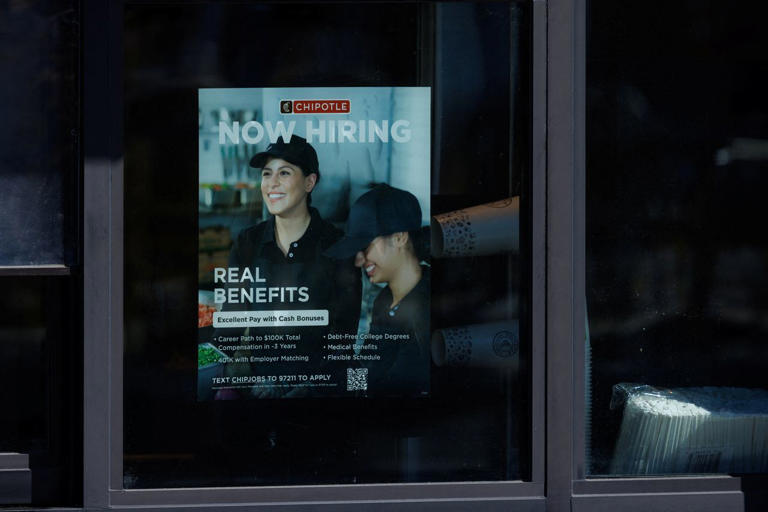
Job growth slowed and unemployment ticked higher last month, marking a break from a string of data showing surprising strength in the labor market.
U.S. employers added a seasonally adjusted 175,000 jobs in April, the Labor Department reported on Friday. That was far less than in March, when gains exceeded 300,000. It was also below the 240,000 economists had expected.
Friday’s report will keep hope alive for a late-summer interest-rate cut from the Federal Reserve, because it eases fears of an overheating economy. Still, it won’t change much for the Fed’s immediate outlook, in part because another employment report is due before officials’ June 11-12 meeting.
Traders in interest-rate futures saw slightly higher probabilities of a rate cut in July after the report, though still below 50%. Expectations of a September rate cut rose to roughly 70%, up from around 60% on Thursday, according to CME Group.
Stocks climbed. The Dow Jones Industrial Average rose 1.2%, or roughly 450 points, its best day in more than a month. The yield on the benchmark 10-year U.S. Treasury note fell to 4.498% from 4.569% Thursday.
Analysts said the April employment report showed that the labor market is cooling but didn’t signal a serious deterioration in hiring conditions. The unemployment rate ticked up to 3.9% from March’s 3.8%. Wages also rose less than anticipated, increasing 3.9% from a year earlier after rising 4.1% in March.
Job gains slowed broadly, with easing particularly noticeable in the government, leisure and hospitality, and construction sectors.
‘A much more sustainable pace’
Fed Chair Jerome Powell has repeatedly said that he is happy that the labor market remains in good shape, and that inflation can come back down to the Fed’s target without a big increase in unemployment.
Even so, a recent run of hotter-than-anticipated inflation has tempered previous optimism that the economy is on a glide path to a soft landing, where inflation would return to 2% without a recession. Some economists have worried that the strength of the job market could help keep inflation elevated by preventing a further slowdown in wage growth.
April’s job gains could be seen as disappointing when measured against much higher numbers in previous months, but “this is a much more sustainable pace,” said Thomas Simons, U.S. economist at Jefferies. “I think this is probably something the Fed wants to see.”
Before Friday, recent data had shown remarkable stability in the labor market. Despite the Fed’s efforts to fight inflation by lifting borrowing costs, businesses have continued to hire at a robust clip, the unemployment rate has risen only modestly, and a report on Tuesday suggested that a slowdown in wage growth has stalled.
Economists have noted that conditions could shift quickly. Past surges in unemployment have often arrived with little warning. Demand for workers has already eased, with declines in the number of job openings and in the share of workers voluntarily leaving their jobs.
The healthy jobs market has made the Fed’s job easier in some ways, allowing officials to keep their focus on inflation. The Fed on Wednesday kept short-term interest rates between 5.25% and 5.5%, the highest in two decades.
Powell reiterated Wednesday that recent inflation data likely means it will take longer before the Fed starts cutting interest rates.
However, Powell also signaled Wednesday that the Fed was unlikely to raise interest rates any further. He suggested that the central bank was ready to cut rates in response to “unexpected weakening in the labor market,” though he cautioned that it would likely take more than a small increase in the unemployment rate for the Fed to act.
“A couple of tenths in the unemployment rate…would probably not do that,” Powell said Wednesday.
A delicate balance
Many analysts say that monthly job growth had recently exceeded expectations partly due to an increase in immigration. That could mean that some new jobs are the result of a larger population, not necessarily a situation where businesses are desperate for workers.
As a result, some recently have focused more on the unemployment rate, which takes into account the size of the labor force. But that number also has its shortcomings because it is based on a smaller survey and tends to be more volatile from month to month than the payroll figure.
A variety of indicators, however, have all suggested that now is a good time to either hold a job or look for one—a major surprise given how aggressively the Fed raised interest rates from early 2022 through mid-2023.
Trying to explain how this happened, some analysts have argued that employers are more reluctant to let go of workers after having had trouble finding them when the economy was recovering from the initial shock of the pandemic.
Rather than lay off workers, businesses have preserved their margins by increasing productivity, shortening work hours or finding more temporary help. Government spending on infrastructure and green-energy projects has also pumped money into the economy.
While investors cheered Friday’s data, analysts cautioned that the threat remains that the labor market could cool too much.
Friday’s report showed a small decline in the average weekly hours of private-sector workers, in addition to the slowing wage growth. That combination could eventually weigh on consumer spending, which has been the engine of the economy, said Brian Rose, senior U.S. economist at UBS Global Wealth Management.
“It can’t be that households spend more than they earn, or their spending increases faster than income forever,” he said. “And this month’s report undermines the income side of it.”
Nick Timiraos contributed to this article.
Write to Sam Goldfarb at sam.goldfarb@wsj.com
Corrections & AmplificationsU.S. employers added a seasonally adjusted 175,000 jobs in April. An earlier version of this article incorrectly said employers added 175,00 jobs. (Corrected on May 3)

